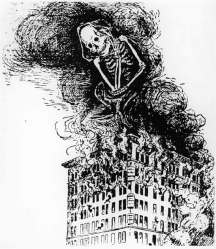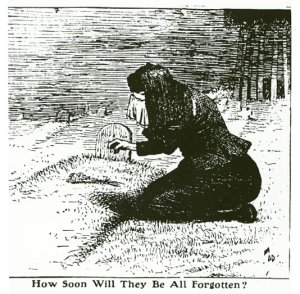From New York Times, "In America; The Sweatshop Lives," by Bob Herbert, on 28 December 1994 -- A form of industrial exploitation that had been concealed from most Americans literally burst into the open with the 1911 Triangle Shirtwaist Company fire in lower Manhattan, which killed 146 workers, mostly young women and girls.
More than a third of the victims died after leaping from the top floors of the eight-story building. Fire Department nets shredded beneath the weight of the falling bodies. The remaining victims either suffocated or burned to death.

Investigations revealed that the women had been working under the most appalling sweatshop conditions. The factory was crowded and cluttered. Flammable fabrics were everywhere. And oil, constantly dripping, was allowed to seep into the wooden floors.
The widespread revulsion and outrage that followed the fire led to substantial improvements in the health and safety standards of factories in the United States and a number of other industrialized countries. But there was a price to pay. When you improve conditions in the workplace, you raise the cost of your goods.

Earlier this month the International Confederation of Free Trade Unions released a detailed report on a catastrophic fire at a toy factory in Thailand in 1993. The death toll of 188 in the fire at the Kader Industrial Toy Company, near Bangkok, surpassed that of the Triangle Shirtwaist fire, making it the worst industrial fire in history.
In many ways the Kader fire was a replay of the Triangle catastrophe. Most of the victims were women and girls. They were the kinds of workers industrialists like best -- young, ignorant, compliant and willing to work long hours under the worst conditions for a pittance. The plant was a sweatshop and safety precautions were ignored. Trapped by the fire, many of the victims leapt to their deaths.

The corporate executives who reap the benefits from the toil of workers like those at the Kader Company go out of their way to keep the exploitative and cruel employment conditions concealed from the public.
Some of the biggest retail names in America -- including Toys "R" Us, J. C. Penney, Fisher-Price, Hasbro and Gund -- have had their toys manufactured at the Kader factory. But young women and girls working in slave-like conditions are not part of the "image" these companies are so careful to project. Bruce Raiffe, president of Gund, was asked if he felt his company bore any responsibility for the working conditions in the plants where his products were made. He replied:
"I would prefer not to get into this because I would prefer not to be included or to have Gund mentioned in the article. It's not exactly the type of article that reflects well on the industry, let alone any particular company."

He added, "We did not produce at Kader for over 18 months before the fire." When asked why, he said, "We weren't satisfied with their quality."
Nearly half of all the toys sold in the United States are produced for brand-name companies by contractors in Thailand, China and other Asian countries. To the delight of the toy industry, the wages and working conditions in the Far East are as bad as -- and often far worse than -- those that prevailed in the U.S. in 1911.
In its report on the Kader fire, the International Confederation of Free Trade Unions said, "Making toys for children must not continue to depend on the burning, suffering and dying of young women workers."

Whether they acknowledge it or not, the leaders in all industries have a responsibility to see that their products are made under humane conditions. Consumers bear a responsibility as well.
Jay Mazur, president of the International Ladies Garment Workers Union, which is a member of the confederation, said: "The terrible Triangle Shirtwaist fire in 1911 spurred Americans to demand and achieve reforms to help insure the safety of all workers. We must be similarly forceful and press for international action to require all producers worldwide to protect workers, to end child labor, and to create safe conditions in their factories."
For most of us, it is almost 1995. A new year -- a new century -- beckons. But in the perpetually ruthless world of the great industrialists, it is always 1911. (source: New York Times)

No comments:
Post a Comment